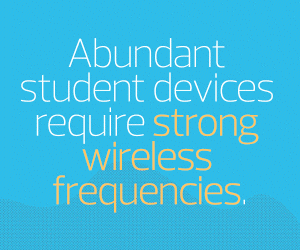2. Professional Implementation Can Yield Better Results
School IT teams used to have a full summer, from June to August, to implement new projects and systems, but summers are getting shorter and shorter. Some schools are beginning their fall semesters in July! This may mean that along with limited staff, schools now have limited time to make a Wi-Fi upgrade happen over a summer break. This is an example of a situation that would warrant bringing in extra people so permanent school staff are freed up to focus on their day-to-day tasks.
The temporary staff can physically move the hardware and place them in racks in the ceiling and elsewhere. There’s also critical software configuration on those components that technical staff can help design. There’s a lot more complexity to newer Wi-Fi. It helps to be educated about signal strength, neighbor access, how many APs other APs can see, how wide your channels can be and the density of devices in certain areas.
You're not going to get the results that you are hoping for if you don’t design it well and use professional implementations,
LEARN MORE: Read why K–12 schools shouldn’t overlook switches and routers.
3. Better Secure Your New System
Having a new Wi-Fi network means more than just plugging in new APs. You will need to secure your new system, which involves deciding how to segment your network and what devices should get access. The last thing you need is to have a rogue AP or unsecured Internet of Things device that can allow someone to jump on your Wi-Fi network, use your bandwidth and hack into your system.
Unfortunately, some schools may not have in-house engineers who can help manage this part of the Wi-Fi 6 upgrade process. The Consortium for School Networking's 2023 State of EdTech Leadership survey found that 66 percent of school districts do not have full-time cybersecurity staff. There are more than 400,000 cybersecurity job vacancies in North America, making salaries very competitive. This can make it hard for schools to afford full-time cybersecurity experts.
Bringing in a virtual CISO or cybersecurity professional on a part-time or contract basis could help schools fill this gap. In addition to managing some of the security issues that schools face, a vCISO can also help them collect and interpret valuable cybersecurity data that can have a dramatic impact on the network.
DIVE DEEPER: Learn how K–12 schools can outsource cybersecurity expertise to vCISOs.
4. Determine Critical Systems to Place in the Cloud for Hardening
As schools plan which parts of their Wi-Fi 6 efforts to outsource, funding is always a concern. When I was a CTO, I worried constantly about what would happen if we experienced a physical disaster and how that would impact the local data centers. I knew cloud storage could help me harden some really critical systems.
However, I couldn’t afford to put all my systems — my student information system and the food and transportation systems — in the cloud. That’s when I decided that in case of disaster, I would need to make sure that employees were able to get paid and that we could pay the district’s other bills. So, I decided to put my financial system in the cloud.
This gave me peace of mind that there would be security professionals actively managing my backup and recovery in the cloud. Of course, this kind of determination is more art than science. Having a trusted partner can help you decide what gives the biggest bang for your buck.
DISCOVER: See how school districts can successfully shift to the cloud.
5. Improve Network Management with Help from Outside Pros
Schools are sometimes severely understaffed, and some are just not able to hire the number of engineers they would need to be at full capacity. In the same 2023 CoSN survey I mentioned earlier, IT leaders said their No. 2 technology challenge was their “inability to hire skilled staff,” and 36 percent said that they were concerned about sustaining their current staffing levels.
Active network management is one of many areas that can be severely impacted by staffing shortages. There are companies looking to ease this burden by helping schools manage, monitor and configure their entire infrastructure, from APs to switches. Other offerings include Wi-Fi as a Service, where a third-party partner helps design your network equipment while allowing in-house control of the network. The best part is that some of this can be covered by E-rate.
EXPLORE: Get answers to commonly asked E-rate questions for K–12 leaders.
6. Having a Partner Can Support Professional Development
The connection between Wi-Fi upgrades and professional development might not be immediately clear. However, upskilling and reskilling school IT staff is one of the top three technology challenges IT leaders face, according to CoSN. Without a properly trained staff, maintenance of your new infrastructure becomes a challenge.
A trusted partner such as CDW can properly assess your staff’s skills, then help them develop those skills so they can backfill those outsourced roles. This can save money in the long run. Plus, knowing that your school can put younger IT staff on a path to systematic career growth can also make joining your district very attractive.
This article is part of the ConnectIT: Bridging the Gap Between Education and Technology series. Please join the discussion on Twitter by using the #ConnectIT hashtag.
![[title]Connect IT: Bridging the Gap Between Education and Technology](http://www.edtechmagazine.com/k12/sites/default/files/articles/2014/05/connectit.jpg)







![[title]Connect IT: Bridging the Gap Between Education and Technology](http://www.edtechmagazine.com/k12/sites/default/files/articles/2014/05/connectit.jpg)




